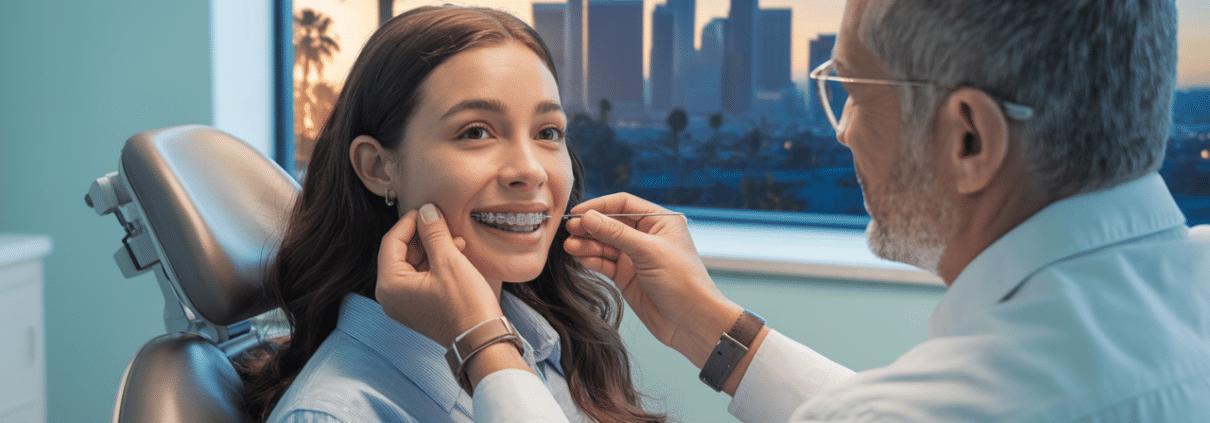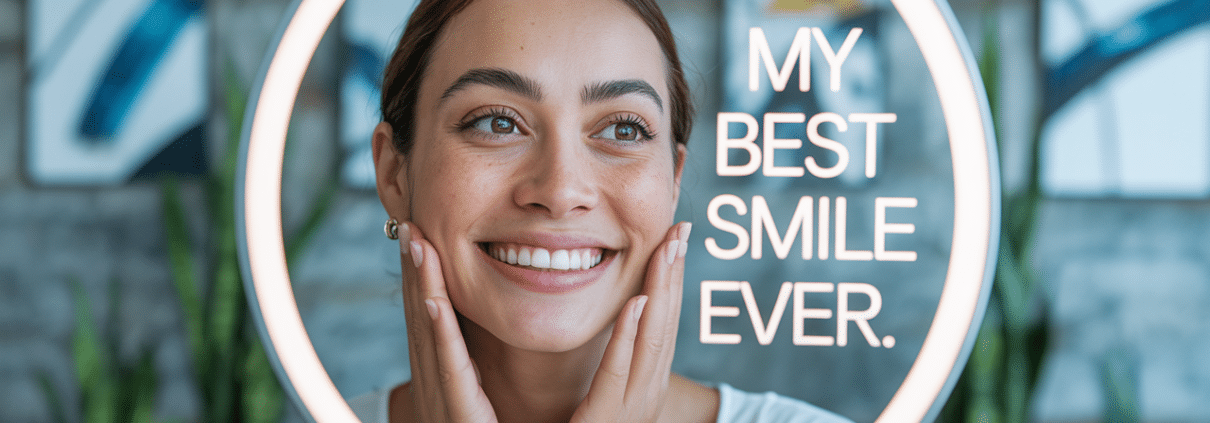Swollen gums might seem like a minor nuisance—until they’re not. If your mouth feels tender, your gums look puffier than usual, or there’s a little bleeding when you brush, it’s not just a “skip-the-dentist” moment. These symptoms could be a neon sign flashing a bigger oral health issue. In Los Angeles, where green smoothies and yoga reign, your gum health deserves just as much daily care.
Understanding the swollen gums causes can help you act early, prevent more serious dental conditions, and keep your smile in check. Whether you’re dealing with soreness, inflammation, or just curiosity, this guide walks you through the main culprits—and when to call your LA dentist.
TLDR – Quick Guide
- Swollen gums can be caused by everything from plaque buildup to vitamin deficiencies.
- Ignoring inflammation could lead to gum disease, tooth loss, or systemic health problems.
- Some causes require immediate dental intervention, while others may just need better hygiene or dietary changes.
- In Los Angeles, dentists like Dr. Valery Sweeny offer comprehensive care with a focus on prevention and education.
Detailed Breakdown: Swollen Gums Causes
1. Poor Oral Hygiene
Let’s start with the classic culprit. When plaque hangs around your gumline, it turns into tartar and irritates your gums. The result? Swelling, redness, and bleeding when you brush. Skipping flossing or brushing half-heartedly allows bacteria to thrive, leading to gingivitis, the earliest form of gum disease.
According to the CDC, nearly half of adults aged 30 and older show signs of gum disease.
2. Gum Disease (Periodontitis)
If gingivitis is left untreated, it can develop into periodontitis—an advanced stage of gum disease. This condition damages the soft tissue and bone supporting your teeth. Swollen gums here aren’t just inflamed; they’re often painful and accompanied by bad breath or gum recession.
The American Academy of Periodontology recommends regular checkups to prevent and detect periodontitis early.
3. Vitamin Deficiencies
Your diet might be sabotaging your gums. Deficiencies in Vitamin C (linked to scurvy) or Vitamin D can make gums inflamed and more prone to bleeding. This is more common in people with restrictive diets or absorption issues.
4. Hormonal Changes
Pregnancy, menstruation, or menopause can trigger gum inflammation due to hormonal fluctuations. Estrogen and progesterone levels increase blood flow to the gums, making them more sensitive to plaque.
Pregnant women are particularly prone to “pregnancy gingivitis,” which affects 60–75% of expectant mothers.
5. Medication Side Effects
Some medications, such as calcium channel blockers, anti-seizure drugs, and immunosuppressants, can cause gum overgrowth or inflammation. If you’ve recently started a new prescription and noticed gum changes, bring it up with your dentist.
6. Tobacco Use
Smoking or chewing tobacco not only stains your teeth—it also restricts blood flow to the gums, reducing healing ability and masking early signs of inflammation. It’s a major contributor to gum disease.
7. Allergic Reactions or Ill-Fitting Dental Appliances
Reactions to toothpaste ingredients, mouthwash, or poorly fitting dentures/braces can also inflame your gums. If your symptoms started with a new product or appliance, there’s a chance your gums are telling you they don’t approve.
When to Book a Dental Visit in LA
Here’s your rule of thumb: If gum swelling lasts more than a week or gets worse, it’s time to see a dentist. Other red flags include:
- Persistent bleeding during brushing or flossing
- Bad breath that won’t go away
- Gum recession or teeth that look longer
- Pain while chewing
- Loose teeth
In Los Angeles, top-rated practices like Valery Sweeny, DDS offer expert diagnosis and treatment plans tailored to your lifestyle and health needs.
Key Takeaways
- Swollen gums are your body’s SOS signal. Don’t ignore them—especially if symptoms persist.
- Common causes include poor oral hygiene, gum disease, hormone changes, and vitamin deficiencies.
- Smoking and medications can also trigger gum inflammation.
- Preventive care and professional cleanings are essential in managing and avoiding swollen gums.
- If symptoms linger or worsen, a dental visit in LA should be your next move.
FAQs
Can stress cause swollen gums?
Yes. Chronic stress can weaken your immune system, making it harder for your body to fight off infections—including those in your gums.
How do I treat swollen gums at home?
Start with gentle brushing, flossing, and rinsing with warm salt water. Avoid irritants like alcohol or tobacco. But don’t rely solely on home care if symptoms persist.
Are swollen gums always a sign of gum disease?
Not always. They could be due to allergies, new dental products, or hormonal changes. But it’s best to rule out gum disease with a professional exam.
What foods help reduce gum inflammation?
Vitamin-rich foods like leafy greens, citrus fruits (for Vitamin C), and fatty fish (for Omega-3s) can support gum health. Hydration is key too.
How often should I see a dentist to prevent gum problems?
Twice a year is standard, but if you’re prone to gum issues, your dentist may recommend visits every 3–4 months.
Los Angeles is a city built on smiles—headshots, auditions, TikToks, or just coffee shop networking. So it’s no surprise that more people are Googling “braces near me” than ever before. But before you book a consult and commit to a year (or two) of wires and rubber bands, there’s a lot you need to know.
Orthodontic treatment is a significant investment, both financially and personally. Whether you’re 14 or 40, getting braces isn’t just about straightening teeth—it’s about transforming your confidence, bite, and long-term oral health. So let’s unpack what really matters when choosing braces in LA.
TLDR – Quick Guide
- Types of Braces: Traditional metal, ceramic, lingual, and Invisalign
- Average Cost in LA: $4,000–$8,000 depending on treatment
- Treatment Timeline: 12–24 months on average
- Key Considerations: Insurance coverage, orthodontist credentials, lifestyle fit
- Best Candidates: Teens, adults, or anyone with crowding, spacing, or bite issues
Implementation Tactics: Navigating Orthodontic Treatment in LA
1. Understand Your Options
There’s no one-size-fits-all in orthodontics. Depending on your needs and lifestyle, here’s what you’re looking at:
- Metal Braces: Most common and typically most affordable. Great for complex cases.
- Ceramic Braces: Tooth-colored brackets for a less noticeable look.
- Lingual Braces: Attached behind your teeth—completely hidden but more expensive.
- Invisalign or Clear Aligners: Removable, transparent trays that are ideal for adults and image-conscious teens.
Want to compare options visually? The American Association of Orthodontists offers an excellent breakdown.
2. Cost and Insurance in LA
Brace yourself—pun intended. LA prices are steep:
- Metal Braces: $4,000–$6,000
- Ceramic Braces: $5,000–$7,500
- Lingual Braces: $8,000–$10,000
- Invisalign: $3,000–$8,000
Pro tip: Some providers offer in-house financing, sliding scale fees, or accept HSA/FSA funds. Always ask upfront.
3. Treatment Timeline and Expectations
Most patients wear braces for 18–24 months. But it depends on the severity of your case and how compliant you are with maintenance.
- Mild cases: As short as 6 months
- Moderate to severe: Up to 2+ years
- Invisalign: Can be faster for less complex cases
4. Choosing the Right Orthodontist
Don’t just Google “braces near me” and call it a day. Vet your provider:
- Credentials: Are they a certified orthodontist (not just a general dentist)?
- Experience: Ask about similar cases and see before/after results.
- Tech: Are they using modern diagnostic tools like digital scanning?
- Reviews: Yelp, Google, and Healthgrades are your friends.
Check out Zocdoc for appointment availability and verified patient feedback.
5. Maintenance and Lifestyle Adjustments
Braces change more than just your teeth. Get ready for:
- Dietary restrictions (no hard or sticky foods)
- Extra oral hygiene steps (hello, interdental brushes)
- Occasional discomfort after adjustments
For Invisalign users, you’ll need to wear trays 22 hours a day—no exceptions.
Key Takeaways
- Orthodontic treatment is highly customizable—choose what fits your goals, lifestyle, and budget.
- Expect to invest time (12–24 months) and money ($3,000–$10,000).
- Invisalign is great for minor corrections and aesthetic preferences, while metal braces handle more complex work.
- Not all providers are created equal. Research credentials, technology, and reviews before committing.
- Successful treatment depends on daily care, follow-ups, and consistency.
FAQs
How do I know if I need braces or Invisalign?
An orthodontist will evaluate your bite, alignment, and spacing to recommend the best option. Some cases may only be suitable for braces.
Are braces covered by insurance?
Some PPO plans cover part of orthodontic treatment, especially for dependents under 18. Always check with your provider.
Can adults get braces too?
Absolutely. Adult orthodontics is more popular than ever. Invisalign and ceramic braces are great discreet options.
What’s the best age to get braces?
The ideal window is 10–14 years old, but many adults achieve great results later in life.
What happens after braces come off?
You’ll likely need to wear a retainer—either fixed or removable—to maintain your results long-term.
You can’t swipe through Instagram in Silver Lake without seeing flawless smiles—whether it’s baristas, bartenders, or band members. The truth is, great smiles don’t just happen; they’re crafted. And when you type “best cosmetic dentist near me” into Google, you’re really asking, who can I trust with my face?
Choosing a cosmetic dentist is more than picking someone who knows veneers from veneers. It’s about finding a skilled artist with medical precision—someone who understands your goals and won’t turn your teeth into Tic Tacs.
TLDR – Quick Guide
- What Cosmetic Dentistry Covers: Veneers, bonding, whitening, Invisalign, and more
- Cost Range in Silver Lake: $300–$20,000 depending on treatment
- What to Look For: Before/after portfolio, reviews, credentials, and personalized consultation
- Tech to Expect: Digital smile design, 3D imaging, laser whitening, and clear aligner scanning
- Bonus: Many cosmetic procedures are fast, painless, and don’t require downtime
Implementation Tactics: How to Find the Best Cosmetic Dentist Near You
1. Know What Counts as Cosmetic Dentistry
Cosmetic dentistry enhances the appearance of your teeth, bite, and smile. Common services include:
- Porcelain Veneers: Cover chips, gaps, and discoloration
- Teeth Whitening: In-office laser or take-home trays
- Invisalign/Clear Aligners: Straighten without the metal
- Bonding: Fix minor cracks or reshape teeth
- Gum Contouring: Reshape gum line for a balanced smile
If it’s about aesthetics, it falls under cosmetic—and your dentist should be fluent in all of it.
2. Inspect Their Portfolio
You wouldn’t book a tattoo without seeing the artist’s work, right? Same logic applies. A top-tier cosmetic dentist should have:
- A robust before-and-after gallery
- Case studies or testimonials
- High-resolution photos (no stock images)
You can often find these on their Google Business Profile or Yelp.
3. Dig Into Their Credentials
Look beyond “DDS” on the business card. Ask:
- Are they a member of the American Academy of Cosmetic Dentistry (AACD)?
- Do they pursue ongoing training in modern techniques?
- Are they certified in clear aligners like Invisalign?
A dental degree is the start. Ongoing education and specialization are the real green flags.
4. Read Reviews Like a Stalker (It’s OK)
The phrase “best cosmetic dentist near me” means nothing without receipts. Check:
- Google Reviews
- Yelp
- Healthgrades
- Zocdoc
Look for mentions of bedside manner, comfort during procedures, and post-treatment support. Cosmetic work is personal—it’s OK to be picky.
5. Book a Consultation First
Good cosmetic dentists won’t rush you into the chair. Expect:
- A detailed consult with digital imaging or mockups
- Honest feedback on what’s realistic (and what’s not)
- Transparent pricing and treatment timelines
Great ones will also ask about your lifestyle, goals, and maintenance capacity before recommending a plan.
Key Takeaways
- Cosmetic dentistry is a blend of science and artistry—choose someone with both.
- Always inspect before-and-after portfolios and ask about certifications in aesthetic techniques.
- Reviews, consultation quality, and transparency are as important as the services themselves.
- Don’t fall for glam offices without substance—clinical outcomes matter more than neon signs.
- The best cosmetic dentist near you should feel like a partner in your smile journey, not just a service provider.
FAQs
How do I know if a cosmetic dentist is legit?
Check their credentials (AACD membership is a plus), read reviews, and ask to see their before-and-after work. You’re trusting them with your face—don’t skip the research.
Are cosmetic dental treatments permanent?
Some are (like veneers), others are semi-permanent (whitening, bonding). Maintenance varies, and your dentist should walk you through all of it.
How much does cosmetic dentistry cost in Silver Lake?
It ranges wildly. Whitening may cost $300–$600, veneers can run $1,000+ per tooth, and full smile makeovers may exceed $15K. Financing is often available.
Is cosmetic dentistry painful?
Most treatments are minimally invasive and performed under local anesthesia or none at all. Expect some sensitivity after whitening or veneer placement, but it’s short-lived.
Will insurance cover cosmetic dentistry?
Rarely. Most cosmetic procedures are considered elective, but some components (like crowns or aligners) may be partially covered by PPO insurance.



